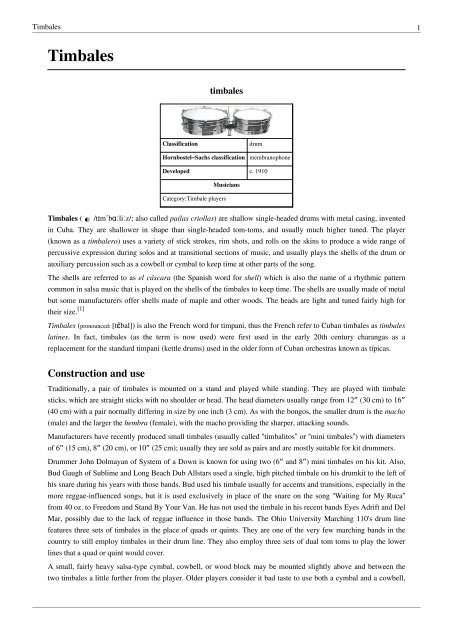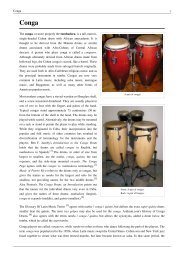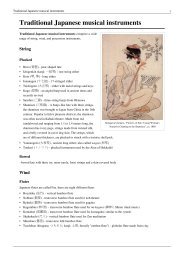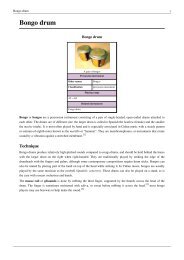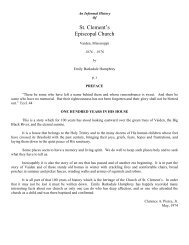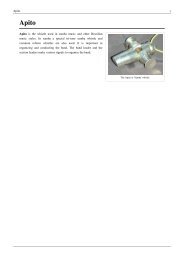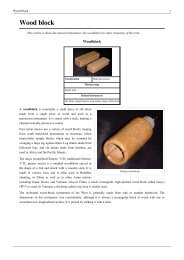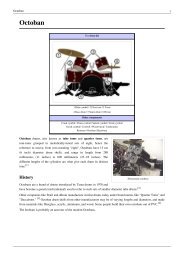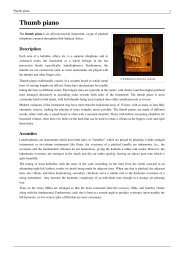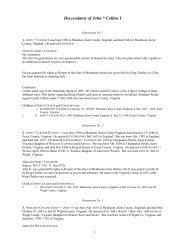Timbales
Timbales
Timbales
Create successful ePaper yourself
Turn your PDF publications into a flip-book with our unique Google optimized e-Paper software.
<strong>Timbales</strong> 1<br />
<strong>Timbales</strong><br />
timbales<br />
Classification drum<br />
Hornbostel–Sachs classification membranophone<br />
Developed c. 1910<br />
Category:Timbale players<br />
Musicians<br />
<strong>Timbales</strong> ( /tɪmˈbɑːliːz/; also called pailas criollas) are shallow single-headed drums with metal casing, invented<br />
in Cuba. They are shallower in shape than single-headed tom-toms, and usually much higher tuned. The player<br />
(known as a timbalero) uses a variety of stick strokes, rim shots, and rolls on the skins to produce a wide range of<br />
percussive expression during solos and at transitional sections of music, and usually plays the shells of the drum or<br />
auxiliary percussion such as a cowbell or cymbal to keep time at other parts of the song.<br />
The shells are referred to as el cáscara (the Spanish word for shell) which is also the name of a rhythmic pattern<br />
common in salsa music that is played on the shells of the timbales to keep time. The shells are usually made of metal<br />
but some manufacturers offer shells made of maple and other woods. The heads are light and tuned fairly high for<br />
their size. [1]<br />
<strong>Timbales</strong> (pronounced: [tɛ̃bal]) is also the French word for timpani, thus the French refer to Cuban timbales as timbales<br />
latines. In fact, timbales (as the term is now used) were first used in the early 20th century charangas as a<br />
replacement for the standard timpani (kettle drums) used in the older form of Cuban orchestras known as típicas.<br />
Construction and use<br />
Traditionally, a pair of timbales is mounted on a stand and played while standing. They are played with timbale<br />
sticks, which are straight sticks with no shoulder or head. The head diameters usually range from 12″ (30 cm) to 16″<br />
(40 cm) with a pair normally differing in size by one inch (3 cm). As with the bongos, the smaller drum is the macho<br />
(male) and the larger the hembra (female), with the macho providing the sharper, attacking sounds.<br />
Manufacturers have recently produced small timbales (usually called “timbalitos” or “mini timbales”) with diameters<br />
of 6″ (15 cm), 8″ (20 cm), or 10″ (25 cm); usually they are sold as pairs and are mostly suitable for kit drummers.<br />
Drummer John Dolmayan of System of a Down is known for using two (6″ and 8″) mini timbales on his kit. Also,<br />
Bud Gaugh of Sublime and Long Beach Dub Allstars used a single, high pitched timbale on his drumkit to the left of<br />
his snare during his years with those bands. Bud used his timbale usually for accents and transitions, especially in the<br />
more reggae-influenced songs, but it is used exclusively in place of the snare on the song “Waiting for My Ruca”<br />
from 40 oz. to Freedom and Stand By Your Van. He has not used the timbale in his recent bands Eyes Adrift and Del<br />
Mar, possibly due to the lack of reggae influence in those bands. The Ohio University Marching 110's drum line<br />
features three sets of timbales in the place of quads or quints. They are one of the very few marching bands in the<br />
country to still employ timbales in their drum line. They also employ three sets of dual tom toms to play the lower<br />
lines that a quad or quint would cover.<br />
A small, fairly heavy salsa-type cymbal, cowbell, or wood block may be mounted slightly above and between the<br />
two timbales a little further from the player. Older players consider it bad taste to use both a cymbal and a cowbell,
<strong>Timbales</strong> 2<br />
but younger players have abandoned this tradition, even incorporating timbales into larger percussion sets including<br />
drum kits. There can be as many as five different kinds of accessories on a timbale set.<br />
Skilled players strike the heads, rims, and shells in rapid succession to produce lively Latin rhythms.<br />
Due to the timbalero Tito Puente (among others), it is now acceptable for a player – especially a band leader – to use<br />
more than two timbales, and a great timbale solo is quite a spectacle. Puente was frequently be seen on concerts,<br />
posters, and album covers with seven or eight timbales in one set, often strapped to him rather than on a stand.<br />
A recent offshoot of the Washington DC funk genre of Go-Go known as the “Bounce Beat” features <strong>Timbales</strong> as a<br />
predominant instrument.<br />
THE BEST TIMBALES EVER MADE<br />
The Leedy timbales were first manufactured in 1944 when a young<br />
Charles Tappan an employee of Henry Adler music store on 46th street was annoyed that he was mounting heads on<br />
The old Cuban timbales and they all broke after they were put on drums due to the bad edges. So he started to make<br />
a timbales with rounded edges and what is know as Leedy was born. AS time went by they were selling timbales<br />
made byCharles tappan in the only store around at that time that had quality timbales and were worth it all other<br />
timbales were made of wood. Many of the set made came with Radio King bread and butter lugs on them and Leedy<br />
Claws. (I will send you a photo of them I don't know how to paste photo). These were the first timbales in the market<br />
they had no labels but sound incredible . In 1945 business was starting to pick up for Henry Adler he moved store<br />
from a second floor to the main floor of building a larger space there all the who is who used to meet every day and<br />
hang out there Gene Cooper, Buddy Rich etc . So Henry decided to to open a school there were he and Charles gave<br />
lessons on drumming. And every so offend built a set of timbales as a specialty item for who ever ask for one. By<br />
1946 business was booming and they just could not keep up so Henry decide to sell the timbales business and<br />
shopped through different company's finally Leedy got interested (Now owned by Conn a horn maker ) brought the<br />
Idea. And started to make timbale under the Leedy name that when the single tags that says leedy only. 1947 Leedy<br />
lunches a campaign to enhance business . So they go back to Henry to put them in contact with re known drummer<br />
Ubardo Nieto but buy the time they contacted Uba he was on way to Europe with the Machito orch.and did not have<br />
the time to sit with company officials. So Henry proposed to go see an other drummer who played well and was with<br />
one of the hit bands of the moment Noro Morales which was playing in a club called China Doll on 53 st Broadway.<br />
There the Leedy officials were mesmerized with Humberto Morales that they sign him on the spot.<br />
By October of 1947 Leedy was ready with mass production and ready to for advertizing and on November 3 1947<br />
the biggest add campaign was lunched. (I sent one of these copy's of the add. January 1948 Leedy was selling<br />
timbales like no tomorrow every one want a set and Leedy could not build them in time. Sale were through the roof<br />
They offered the timbales with case and a set of sticks for $75.00 incredible but true. 1949 they lunched another<br />
campaign to celebrate great sales and made an anniversary set of timbales with red labels of this set they made very<br />
few about 50 set that sold out very quickly. In 1950 business had pick up that Conn buys Ludwig and Ludwig drums<br />
and put a gentleman buy the name George H. Way another drum wiz incharge. George H.Way dicides to Join both<br />
company's since they were both top companys and did not want competition between company so in 1951 the Leedy<br />
& Ludwig company in born. The Tag continued with same tan color till mid year of 1951 mean time they finished<br />
there transition. As transition took place they made a few changes to the timbales inside plate were shortened and the<br />
Humberto Morales tags went from Brass to steel. This is why you will see many different designs some round others<br />
square on Leedy. Mid 1951 they finally decided on black and gold tags with the steel Humberto tag. This lasted till<br />
1954 that company seized production of the timbales. And sold all its stock to a Indiana Music store. 1954 - Bud<br />
Slingerland buys Leedy Co.'s dies and patents from C.G. Conn Co. for $90,000US.<br />
As they broke up the company Ludwig was return to William F Ludwig one othe Ludwig hears and the company<br />
started to produce under the WFL name because Ludwig name was under contract still.1957 taking advantage that<br />
there were no timbales in the market WFL made a copy of the Leedy timbales in steel with claws putting 6 and 8
<strong>Timbales</strong> 3<br />
claws on the drums this only lasted for one year they later got the Ludwig Name and change rims to cast iron rims.<br />
Slingerland even though he had dies did not produce timbales till 1958 to compete against Ludwig and Gretsch, that<br />
were making copies of what Leedy had built. Slingerland then changed every thing on the timbales making them<br />
more economic inside plate very thin, shell's 6 the rim the to make up lost inch on shell they made rim 1 ¼ ,brass<br />
claws every thing was cheaper made, yet made a better stand than what Leedy made . Leedy's stand was made to<br />
accommodate Humberto Henry, and Charlie they were all 5'1 -5'2 in height that became a problem back then the<br />
taller drum had to play sitting down.<br />
Bud Slingerland was not a drummer but a savvy business man and made many change that lead company to<br />
discontinue the timbales. Also there was another company that was giving Slingerland hell making timbales and of<br />
better quality just as good as the old Leedy and better than what Leedy had produced. That company was Rogers<br />
they started making timbales of a better quality than Leedy and every one else. Rogers came with a better stand tilt,<br />
heavier base, shell did not dent much better Gage, and 5 lugs more room to play cascara and you did not have to drill<br />
drums to mount cowbell. 1967 they signed Humberto Morales and the Humberto model was released but 1968<br />
Humberto died and that Came to an end. This is an other company that sold there ideas after they were up on top to<br />
company's like CBS and Yamaha that have no business in drumming and destroy quality.<br />
Fred Gretsch buys Slingerland and the Leedy name 1980 to just take the competition out of the game made a few<br />
sets but nothing interesting the best gretsch timbales were made under his fathers rain of the company Fred Gretsch<br />
SR. Todays Gretsch drum kits are done with some Leedy ideas and some Slingerland. These company's discontinued<br />
the making of <strong>Timbales</strong> since LP has cornered the Market.<br />
But Leedy and Rogers still remain king of the throne. Here is a comment Walfredo De los Reyes sent me recently on<br />
face book .<br />
Walfredo de los Reyes Quote<br />
"Their sound was unique. Everyone played them in the<br />
forties,I have two pairs. They are a treasure."<br />
Yet the inventor of the best timbales in the world Charles<br />
Tappan died on his way home to New Jersey, his car got stuck in a snow storm and he froze to death they found him<br />
in his car days later. He was still teaching at the time of his death in Manhattan .<br />
Henry Adler also went to write many books also made movies (seeking Susan) and the most famous book bible on<br />
timbales playing with Humberto Morales vol 1+2 . And dies a few years ago in florida at age 100+ years old .<br />
And today Leedy timbales are the most sorted timbales in the industry as Walfredo put it There sound is unique<br />
History of Leedy <strong>Timbales</strong><br />
Leedy Manufacturing Drum Company 1900: Founded by Ulysses G. Leedy, Indianapolis, IN.<br />
1929 (September): the Leedy company is sold to C.G. Greenleaf, president of the Conn Company. The stock market<br />
crashed about 30 days later on October 24, 1929. The company is moved to Elkhart, IN.<br />
1930: Ludwig & Ludwig was also purchased by Conn.<br />
Changes made under the Conn Company Leedy manufacturing had to share manufacturing quarters with Ludwig &<br />
Ludwig. There was a reduction in size of the shell reinforcing hoops. Conn continued manufacturing Leedy drums<br />
with the Leedy badge. The first Leedy <strong>Timbales</strong> were manufactured during this era (exact year unknown).<br />
1950: In an effort to save costs, the two drum divisions are combined to form Leedy & Ludwig Drums. When Conn<br />
joined both companies, they shortened the inner plates on the timbales by 1/4 inch, causing drums to bend inwards a<br />
bit. This is only on Leedy & Ludwig timbales with the black & gold badge. They were the first model under Leedy<br />
& Ludwig. It does not happen with the tan and gold badge. (info from Cuco)
<strong>Timbales</strong> 4<br />
1955 (May 4): Conn sells the Leedy name to Slingerland; the Ludwig & Ludwig to Wm. F. Ludwig at the WFL<br />
Drum Co. Each company paid $90,000. Slingerland does not produce timbales until 1958.<br />
1956: Slingerland’s first Leedy catalog is published. However, they did not manufacture timbales until 1958.<br />
Slingerland marketed Leedy drums as their second line with the intention of putting competitive pressure on Ludwig.<br />
1957: the first WFL timbales appear. This was the only year that they manufactured timbales with claws. Guillermo<br />
Barreto played on these timbales on the famous Descargas in Miniature LP w/ Cachao.<br />
WFL timbales, Photo by Faustino Cruz (Cuco)<br />
1966: The last Leedy catalog by the Slingerland company is published.<br />
1986: The rights to the Leedy name were sold to Fred Gretsch Jr. when he bought the Slingerland company. There<br />
are no plans to revive the Leedy name.<br />
<strong>Timbales</strong>: Leedy / Leedy & Ludwig 13” x 7” and 14” x 7” polished brass lacquered shells Spun brass reinforced shell<br />
edges “Beaver Tail’ lug (used through the Slingerland years till about 1970) Self-aligning “Beaver Tail” Rods Heads<br />
tucked on metal counterhoops – no flesh hoops steel claws shells are 7 tall rims are ¾” tall lugs are made of cast<br />
steel inner plates much thicker and wider stand base is smaller but more sturdier Top post was 2 feet<br />
Endorsers: Humberto Morales, Frank “Chico” Guerrero, Tony Escoiles, Tito Puente, Ubaldo Nieto<br />
Slingerland / Leedy <strong>Timbales</strong>: brass claws shells are 6 thinner shells rims are 1” lugs are made of cast iron inner<br />
plate are much thinner stand base is wider than Leedy Top post was 2 feet and 6 inches to accommodate taller<br />
people.<br />
1959-1965: Slingerland made Leedy timbales. Although Leedy lugs were still used on the Slinger-Leedy drums, the<br />
shells, hoops, and even strainers (for snare drums) were Slingerland design. The line was eventually discontinued<br />
around 1965.<br />
1966-1970: They made changes on the claws and lugs<br />
1970 -1972: They changed the rims to regular drum rims and the stand became a clip mount similar to the Ludwig<br />
mount.<br />
1977-78: They also made a Slingerland copy of LP timbales. They did not sell much.<br />
1979: the Leedy name was sold to Fred Gretsch. He discontinued timbales made by Slingerland. He made a limited<br />
number of timbales under the Gretsch name (13x14). Today, Leedy belongs Stto even Maxwell. He does not make<br />
timbales nor is interested<br />
Notes From Monchito Muñoz (interview)<br />
“Gene Krupa was endorsing the Radio Kings made by Slingerland. Therefore, Leedy needed a model name for these<br />
timbales. These people didn’t know anything about Latin music. They were Americans from Chicago so they asked<br />
Henry Adler for advice. The head of Leedy wanted to come to New York and go to a club and see a heavy timbalero<br />
play on these drums. Henry was going to take him to see Uba with the Machito orchestra. The timbales were going<br />
to be named after Ubaldo Nieto. When the head of Leedy came, Machito was on the road. Therefore, Henry took him<br />
to see the Noro Morales orchestra at the China Doll with Humberto on timbales. That is how the timbales became<br />
known as the Humberto Morales Model. This was around 1948 or 1949”. (Monchito Munoz)<br />
Notes From Cuco<br />
Old timbales made of brass had a thinner gage (gauge?) of brass. Today, they make them to last forever. Brass that is<br />
very thick does not sound proper. Also, skins used today are plastic. They have a lot of overtones. The older sets<br />
with Leedy, Leedy & Ludwig, and Rogers were made with a thinner gage of brass and had calfskins on them. That<br />
made the drum sound a lot better; no overtones.<br />
Also, the cascara (side of the timbales) was more mellow. They had the sound of a pair of maracas like it should. The<br />
sound was not as loud as new sets made of steel. They had a warmer sound not like today’s that are very loud. You<br />
have to use ½’ sticks for them to be heard. On the older sets, 3/8” is recommended, producing a warmer sound.
<strong>Timbales</strong> 5<br />
Most companies & custom makers copied the LP (Latin Percussion Co.) design which is in fact, a crude design<br />
copied from the timbales of Ulbaldo Nieto (timbalero of Machito & his Afro Cubans in the 50’s).<br />
The original type was made by a guy called “El Indio” in Manhattan. It was a 5 lug, top tuned set with calf skin<br />
heads. They had the same style rims, tuning bolts, and “L” shaped lugs.<br />
The drum sizes were standardized at 13 & 14 inch shells until LP made the Tito Puente model with 14 & 15 inch<br />
shells.<br />
Gon Bops created a classic brass shell in various sizes including timbalitos & wood shell tarolas which used top<br />
tuned bongo hooks (shorter hooks) which hooked to cast aluminium lugs and had eagle claws over the rims...like<br />
vintage timbales by Leedy, Slingerland, Ludwig, Rogers and Gretsch as well.<br />
History of the term in Cuba<br />
The term timbal or timbales (pl.) has been used in Cuba for two quite<br />
different types of drum. In the first place, it was first used to describe<br />
the kettle drums used in the wind orchestras known as orquestas<br />
típicas. [2] These were the same general type of drum used in military<br />
bands, perhaps slung either side of a horse, and in classical orchestras.<br />
These were, and are, played with sticks which have softish round<br />
heads.<br />
The orquestas típicas were gradually replaced early in the 20th century<br />
by charangas. The general idea of the charanga was to replace the wind<br />
instruments with violins and flute to bring a brighter, lighter tone to the<br />
band. The timpani were replaced by pailas criollas, which were<br />
originally designed to be used by street bands. They were taken over<br />
by the early charangas; their original name was used in Cuba, but over<br />
time the simpler term timbal has been taken over to describe the pailes.<br />
Pailas are always hit with straight batons [3] that have no additional<br />
head. Hits are made on the top and on the metal sides. There is often a<br />
second set of even smaller drums, timbalitos, which produce an even<br />
higher note when struck. In a modern band the timbalero may also<br />
have a trap kit to switch to for certain numbers. [4]<br />
Arturo Sandoval on timbales at the Hard Rock<br />
Cafe, Times Square.<br />
Thus the term timbales is ambiguous when referring to bands playing the danzón in the 1900–1930 period. If one<br />
does not have a photograph it is difficult to know which type of drum was used by the band.<br />
Genres<br />
<strong>Timbales</strong> can be heard in:<br />
• Danzón<br />
• Mambo<br />
• Salsa<br />
• Latin Jazz<br />
• Cumbia<br />
• Merengue (played by the tamborero, or tambora player)<br />
• Manele<br />
• Neo-Bossa Nova<br />
• Reggaeton
<strong>Timbales</strong> 6<br />
• Latin rock<br />
• Reggae<br />
• Rock steady<br />
• Ska<br />
• Go-Go<br />
• Rock<br />
Other countless Latin genres feature the timbales, as they are constantly being incorporated into new styles of music.<br />
Veteran players<br />
• Guillermo Barreto<br />
• Tito Puente<br />
• Amadito Valdés<br />
• Nicky Marrero<br />
• Pete Escovedo<br />
• Willie Bobo<br />
• Ubaldo Nieto<br />
• Roberto Pla<br />
• Jose Luis Quintana "Changuito"<br />
• Marc Quiñones<br />
• Luisito Quintero<br />
• Louie Ramirez<br />
• Ray Romero<br />
• Willie Rosario<br />
• Jimmy Sabater<br />
• Orestes Vilató<br />
• Calixto Oviedo<br />
• Eguie Castrillo<br />
• Aníbal López<br />
References<br />
[1] Orovio, Helio 1981. Diccionario de la música cubana: biográfico y técnico. Entries for Paila criolla; Timbal criolla.<br />
[2] see examples in Early Cuban bands.<br />
[3] thicker than standard drumsticks, and not shaped: they are of uniform thickness along the length.<br />
[4] Orovio, Helio 1981. Diccionario de la música cubana: biográfico y técnico. Entries for Paila criolla; Timbal criolla; Típica (orquesta);<br />
]]<br />
Charanga.
Article Sources and Contributors 7<br />
Article Sources and Contributors<br />
<strong>Timbales</strong> Source: http://en.wikipedia.org/w/index.php?oldid=458006979 Contributors: 7, Abyssadventurer, Angelastic, Barticus88, BashmentBoy, Chase me ladies, I'm the Cavalry,<br />
Cuquito717, Dinobass, Dogman15, Elliot2005, EvanSeeds, Flamurai, Fratrep, Freddythehat, FreplySpang, Goldscarf2, Gus, Howcheng, Howlyn, Hyacinth, Impy4ever, Japanese Searobin,<br />
Johnny99, Lupin, Macdonald-ross, Neon white, Nixeagle, Onehawkxeno, Opus88888, Paddles, Philippe, Rapuello, RdCrestdBreegull, Rjwilmsi, SkaMasta097, Slysplace, Snarescience,<br />
Tassedethe, TenIslands, Tortabrasileira, Txebixev, Wetman, Wintran, Woohookitty, ZooFari, 93 anonymous edits<br />
Image Sources, Licenses and Contributors<br />
Image:timbales1.jpg Source: http://en.wikipedia.org/w/index.php?title=File:<strong>Timbales</strong>1.jpg License: Creative Commons Attribution-Sharealike 3.0 Contributors: Opus88888<br />
File:Loudspeaker.svg Source: http://en.wikipedia.org/w/index.php?title=File:Loudspeaker.svg License: Public Domain Contributors: Bayo, Gmaxwell, Husky, Iamunknown, Mirithing,<br />
Myself488, Nethac DIU, Omegatron, Rocket000, The Evil IP address, Wouterhagens, 14 anonymous edits<br />
File:ArturoSandoval.JPG Source: http://en.wikipedia.org/w/index.php?title=File:ArturoSandoval.JPG License: Public Domain Contributors: Richiebits<br />
License<br />
Creative Commons Attribution-Share Alike 3.0 Unported<br />
//creativecommons.org/licenses/by-sa/3.0/


